So, we come back to our slide show after a four-week intermission (click here to read the blog, Stew and Sandy’s Summer Vacation in Paris). Hopefully you enjoyed a rather lengthy blog about our adventures in Paris. I tried to mix a travelogue with historical tidbits.
So, settle back once more and join us during our days in the U.K., specifically London and Glasgow. Make sure your drink is filled and buttered popcorn is plentiful.
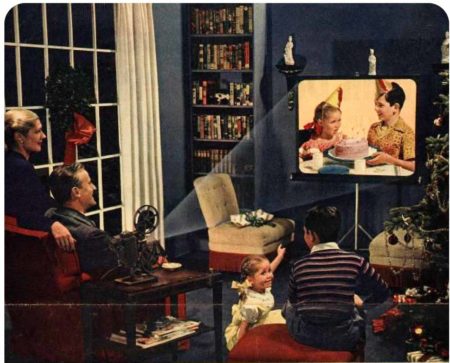
Did You Know?
Did you know that on 16 July, France officially remembered the 80th anniversary of the Vel d’Hiv roundup? The country is frantically trying to collect eyewitness accounts of this tragic two-day event in which more than thirteen thousand Jews in Paris were arrested and ultimately deported⏤most of whom never returned. (click here to read the blog, The Roundup and Cycling Arena) The survivors of the roundup and in particular, those detained at the Vel d’Hiv are now in their mid-to-late 90s and there are few of them remaining. Previous roundups targeted primarily foreign-born Jewish men. However, by mid-1942, French-born Jewish men, women and children were targeted for arrest. (More than half of the Jews arrested over those two days were women and children with children accounting for four thousand of the detainees in the large cycling arena.)
The Mémorial de la Shoah in Paris (i.e., Holocaust Museum and Memorial) has launched an appeal to find the last witnesses and survivors. The historians know thousands of stories are permanently lost but they are constantly amazed how many witnesses show up to recount their stories. In most cases, it is the first time since the war that these people have talked about their experiences. Despite eighty years later, their memories are as fresh as if the events happened yesterday.
Joseph Schwartz was fifteen at the time of the roundup. He lost his entire family after the French police made the arrests. He said, “You leave your parents one day, everything is fine. They kiss you; they tell you, ‘Take care of yourself,’ and the day after, there is nobody left.” Looking back, Joseph is shocked that the French police were granted medals for resistance. He says, “Preserving the memory is always necessary for a nation. Hiding the dark days of a country brings nothing to the future of that country.”
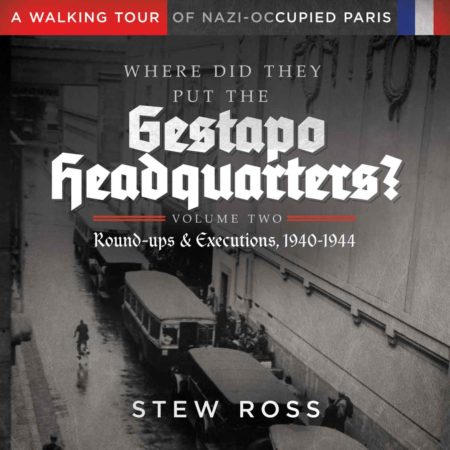
Day Eight: Underground to London
Today was travel day on the Eurostar. We were leaving Paris and going to England via train under the English Channel. I’m glad we got to Gare du Nord earlier than normal. It took us more than one hour to go through six check points. We eventually settled into our seats for the two-and-a-half-hour trip. Believe it or not, the actual time in darkness is less than twenty minutes. We were really under the channel for probably only fifteen minutes⏤the train travels very fast. We pulled into London’s St. Pancras International rail station just in time for lunch.
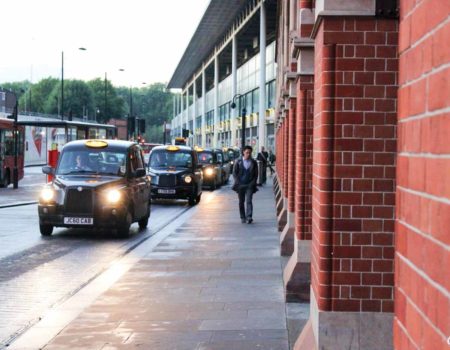
A short cab ride away was our hotel, Dorset Square Hotel, facing the private Dorset Square. On the way, we were glad to see that the red double-decker buses did not go the way of the red telephone booths. The cabs remain black in color but probably twenty percent of them are electric and they are all quite roomy. After checking in and leaving our bags, off we went to find Harrods Department Store. Dinner that night was at The Rajdoot, a small Indian restaurant right around the corner from the hotel⏤it was an excellent culinary experience. (While traveling in England and eating Indian cuisine, we have never had anything less than a first-class meal.)
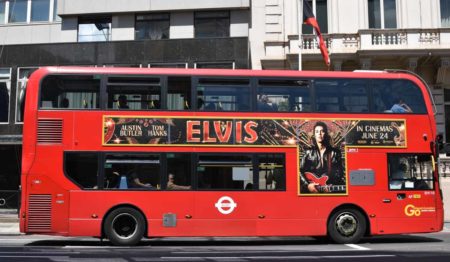
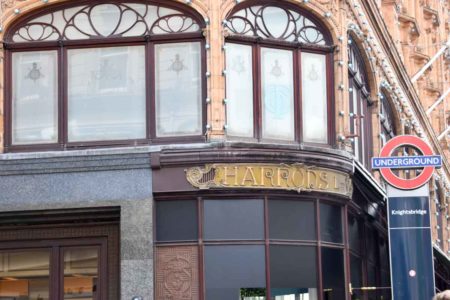
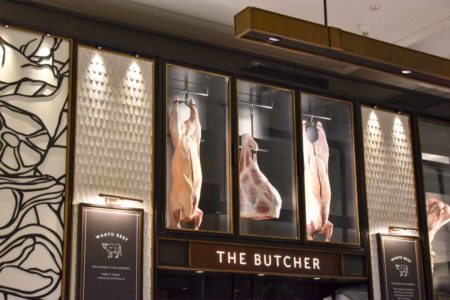
Day Nine: London and Bletchley Park
We took the early morning West Midlands train out of Euston Station to Bletchley Park (click here to visit the web-site). This was the top-secret headquarters for Britain’s cryptanalytic and signals intelligence organization, the Government Code and Cypher School (GC&CS), between August 1939 and March 1946. It was here that the best brains in Britain (men and women) deciphered the German military codes during World War II. It is estimated that the “Ultra” intelligence produced at Bletchley shortened the war by two to four years. The Ultra program penetrated the secret communications of the Axis powers by decoding the German Enigma and Lorenz ciphers.

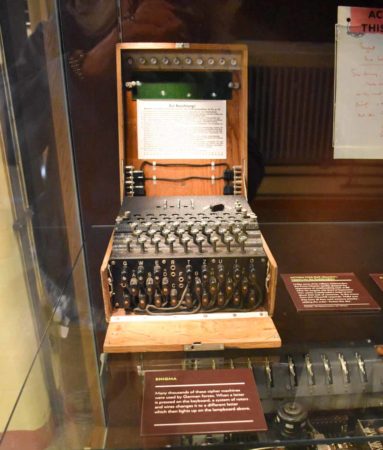
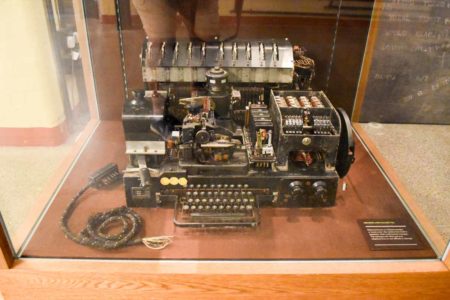
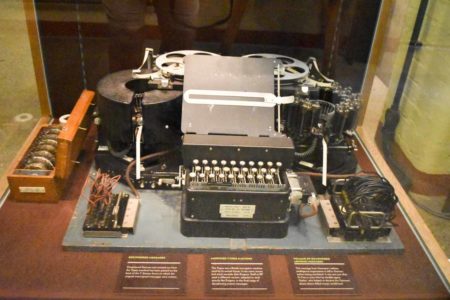
Click here to read the blog Double Cross System.
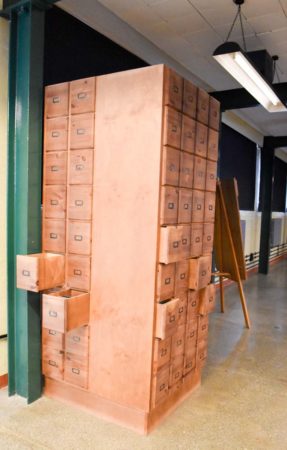
Admiral Sir Hugh Sinclair, head of Secret Intelligence Service, bought the property in 1938 and moved GC&CS into the mansion with Commander Alastair Denniston establishing his office on the ground floor. Dillwyn “Dilly” Knox, Alan Turing, and other really, really smart people were recruited as cryptanalysts.
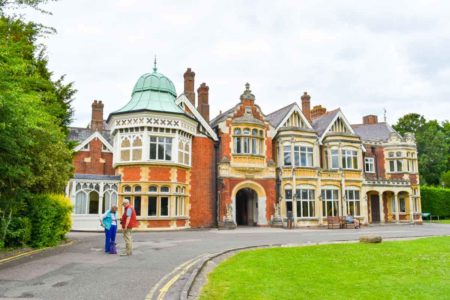
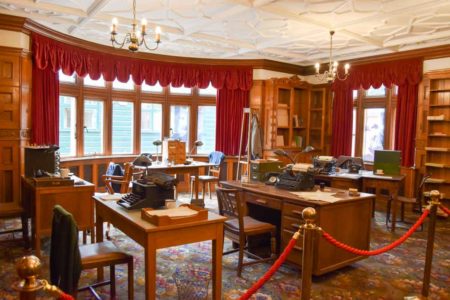
Over time, GC&CS expanded, and huts and blocks were built to accommodate the various decentralized work groups (e.g., Hut 14 – Communications center, Hut 1 – Wireless station, Hut 8 – Cryptanalysis of Naval Enigma, and Hut 4 – Naval intelligence). At its peak, Bletchley Park employed about three thousand people. Turing and Knox lived in apartments established in the stable yard cottages. Turing broke the Enigma code in his apartment.
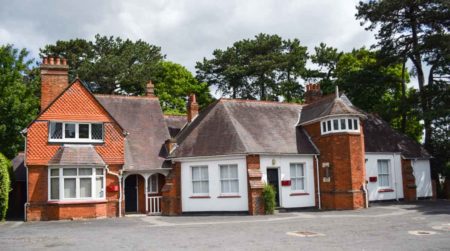
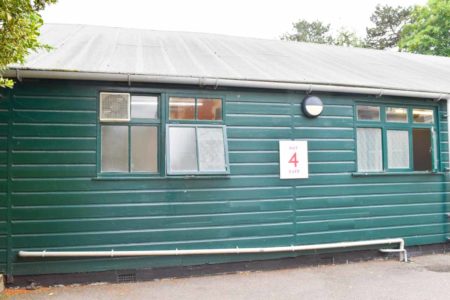
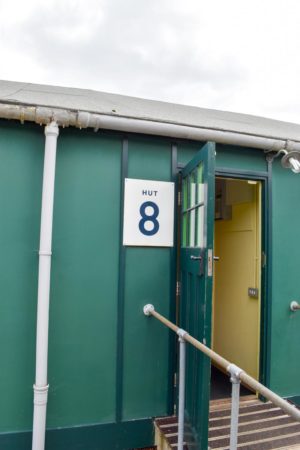
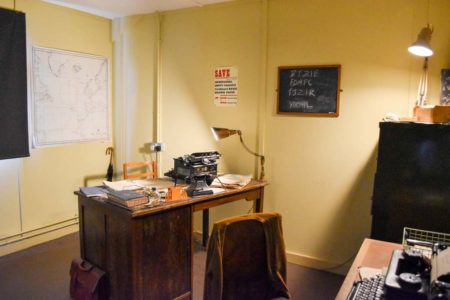
There were many women recruited to work at Bletchley. (Click here to read the blog, Unit 387 & Hillsdale College). They were instrumental in breaking codes, some of which directly resulted in British military victories. Unfortunately, it was not until 2009 that the British government acknowledged the work performed by the Bletchley men and women.
We were extremely impressed with Bletchley Park and its restoration, historical presentation, and administration. Today, the Bletchley Park Trust is responsible for this unique piece of history. If you haven’t visited Bletchley Park, please make sure it is a stop on your next trip to England.
Day Ten: Borough Market and the SOE Memorial Monument
We were originally scheduled to catch a train from Paddington Station to go out to Bracknell to visit with Pat Vinycomb and her father, Stanley Booker (click here to read the blog, Last Train Out of Paris). Unfortunately, Stan was in the hospital. His family had thrown a big party for his 100th birthday (click here to read the blog, Stanley’s Century) and Pat said he must have celebrated too much. Anyway, we found ourselves with an open day.
So, off we went beginning with a stroll down Baker Street. Yes, there is a Sherlock Holmes museum on Baker Street. We opted not to go; instead, we found ourselves in the “official” Beatles retail store. I always found listening to music beat out reading a detective book. (I do both now.) From there, we walked until we reached 64 Baker Street. During the war, this was the headquarters of Special Operations Executive, the British-led secret organization used to drop agents into occupied countries to assist with resistance efforts. Unfortunately, it is now a commercial office building, and the only hint of its wartime activities is the commemorative blue plaque on the front of the building. Along the way, we encountered Chiltern Court on the corner of Baker Street and Marylebone Road. Now an apartment building, during the war three flats served as offices for the SOE Norwegian Section. It was here that the planning for the famous Telemark raids took place (click here to read the blog, Heavy Water). Again, only a commemorative blue plaque gives away the building’s contribution to the war efforts.
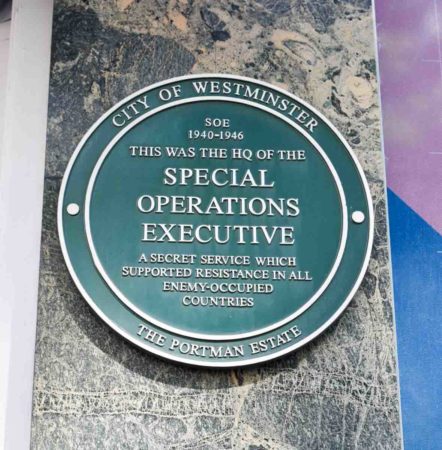
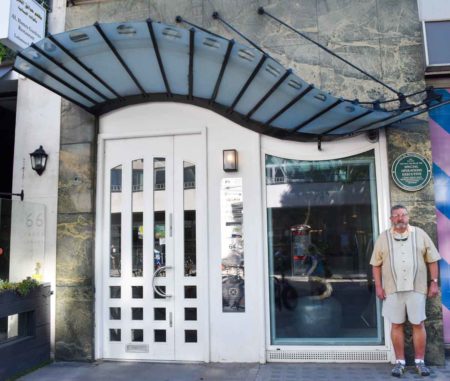
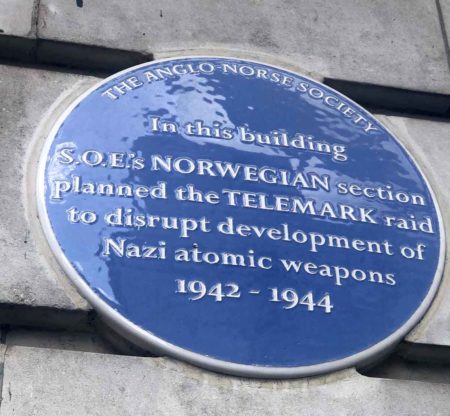
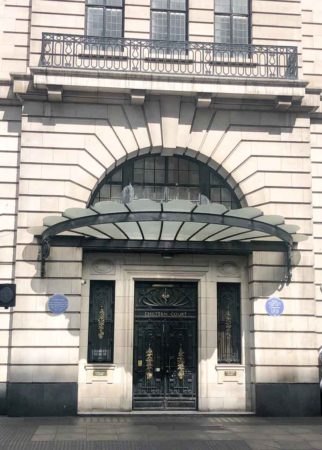
We then made our way to The Temple Church, founded by the Knights Templar in the 12th-century (click here to visit the church web-site). Refer to my books, Where Did They Burn the Last Grand Master of the Knights Templar? (Click here to see the books). The church is surrounded by an area referred to as “The Temple.” This area is the principle legal district in London and one of its access points is through the Mitre Court passageway off Fleet Street.
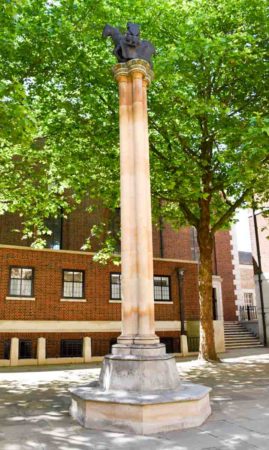
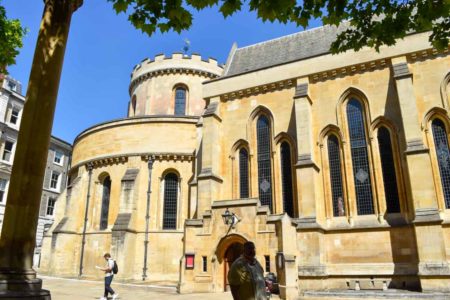
By now, we’re getting hungry and decide to have lunch at the Borough Market. Sandy wishes we had one of these where we live. Established in 1756, it is one of London’s premier outdoor markets. Good lunch but we were looking forward to dinner that evening at our favorite London seafood restaurant, Scott’s.
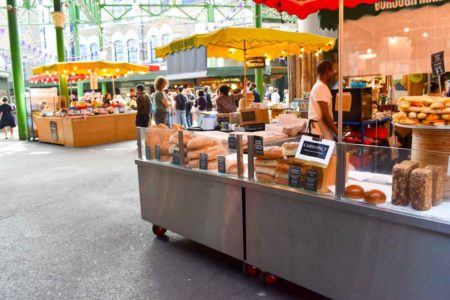
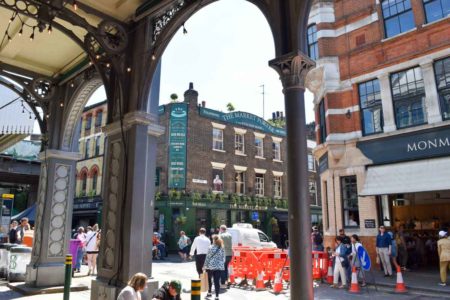
After lunch, we headed over to the Thames’ riverbank. Our objective was to locate the SOE Memorial Monument. It was a long walk but we got to walk under the London Eye, or Millennium Wheel. I think it’s the biggest ferris wheel I’ve ever seen. The view from the south bank of the parliament buildings and Big Ben is very scenic. We finally reached the monument. Unveiled in 2009, this is a memorial to the SOE agents of World War II. (click here to read the blog, Women Agents of the SOE). The bust is modeled after Violette Szabó, a F-Section agent who was captured, tortured, and interrogated by the Nazis before being sent to KZ Ravensbrück. In February 1945, Violette was executed at the age of twenty-three. Violette is one of only four women to have been directly awarded the George Cross (GC). The stone pedestal has a plaque dedicated to the 470 SOE agents who were sent on missions into occupied France. Another plaque is dedicated to the SOE agents who did not survive. The final plaque is dedicated to the Norwegian Resistance fighters sponsored by the SOE. It specifically calls out the agents who participated in the operation known as Telemark. Our next trip to London will include a visit to the Imperial War Museum where we can see the exhibit displaying Violette’s medals including the GC. Oh, our next trip will also include a stop at the Violette Szabó Museum founded in 2000 by Violette’s aunt. (Click here to visit the museum web-site).
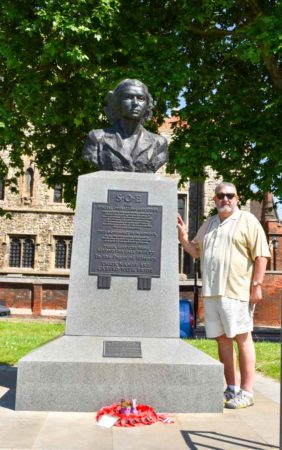

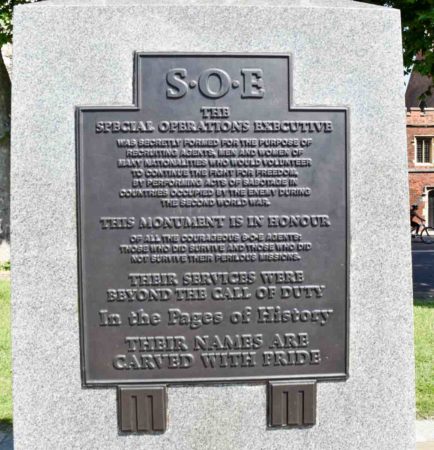
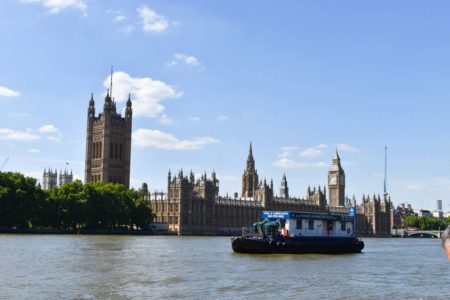
Day Eleven: Madame Tussauds London
Today, we have Madame Tussauds scheduled in the morning. It is right down the street from our hotel and our reserved time is 10:30 AM. The last time I came here was in 1965 when I was ten. I remember entering the main hall with the giant exhibit of Admiral Nelson dying on the top deck of his ship, HMS Victory, during the 1805 Battle of Trafalger. Smoke, cannon shots, and men shouting drowned out any visitor’s conversation. It was quite spectacular. When Sandy and I entered the main hall, we were greeted by three sets of elevators and a person directing us into one of them⏤strike one against Madame Tussaud. As we walked through the pathways and entered the halls, I seemed to recognize only about half the people⏤strike two against Madame Tussaud (and possibly me). To my credit, I did recognize Angela Jolie and her ex, Brad Pitt (they were separated from one another). I was also able to recognize the historical figures including the Royal Family (sans Harry and Megan), Chewbacca from Star Wars, and the Hulk. One of the biggest impressions I had as a ten-year-old was in the basement where The Chamber of Horrors was located. Almost sixty years later, it was no longer a part of the “museum” experience⏤strike three against Madame Tussaud. I was extremely disappointed. Sandy didn’t care. I think she has been sufficiently grossed out after helping me with the two French Revolution books (Where Did They Put the Guillotine? click here). Over the past forty-six years, she is very familiar with my interest in the macabre.
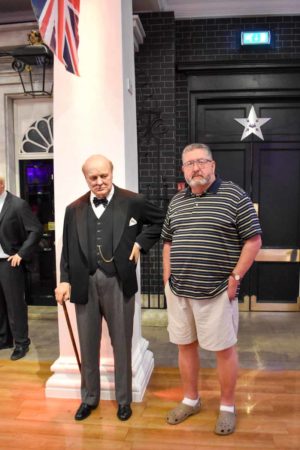

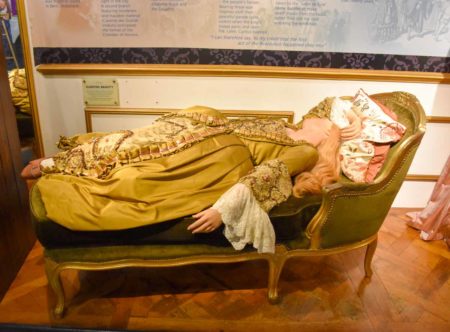
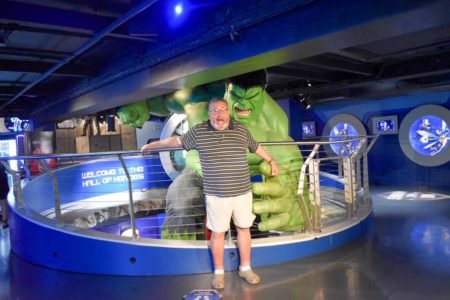
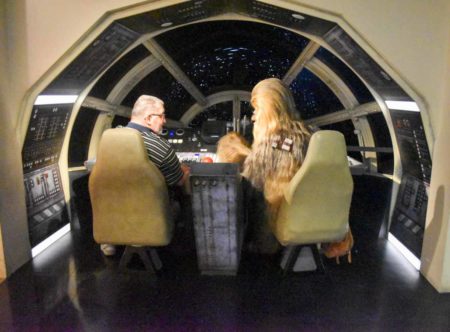
The remainder of the day was spent walking around London. We visited Regent Street as well as Carnaby Street. (This current version isn’t the one I remember from 1967.) One of our stops was to Liverpool Street Station, a large rail station. I wanted to see the statues memorializing the Kindertransport program, or “Children Transport.” (click here to read the blog, Kindertransport and Mr. Winton). Through the efforts of many people, ten thousand children (three-quarters of them were Jewish) were sent to England to be “adopted” by a family. Many of them arrived at Liverpool Street Station. Once war began on 1 September 1939, the borders were closed, the “underground” railroad was shut down, and many children were stranded to ultimately be lost in the extermination camps.
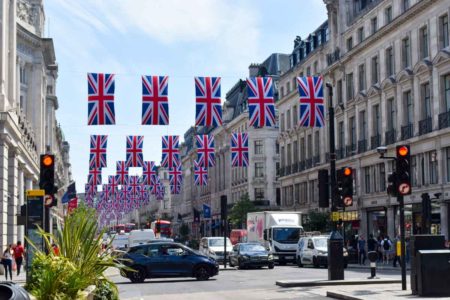
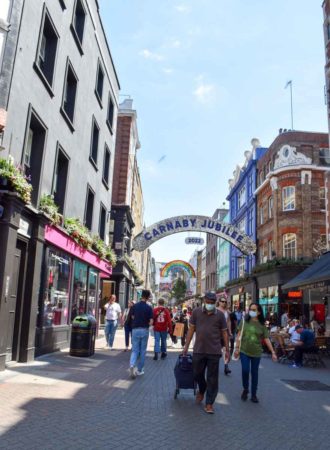
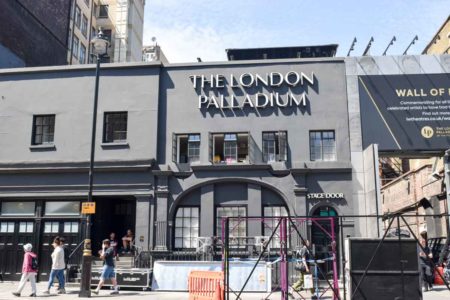
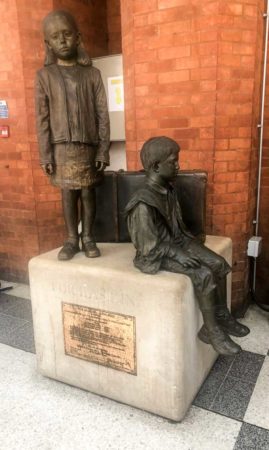
Day Twelve: Travel to Glasgow, Scotland
Today, we grab our train at Euston Station and leave for Glasgow, Scotland. We’re scheduled to meet up with our friend Roland. We began corresponding with Roland years ago after he contacted us about one of our blogs. Roland’s career has been in the entertainment industry, and he is currently a location scout for various production companies. Our initial correspondence in 2020 centered around his dream project of producing a documentary on Antonia Hunt, an English teenager caught in occupied France (her book is referenced below). She got involved with the French Resistance including the Red Orchestra (click here to read the blog, Die Rote Kapelle). Roland was planning a trip to Paris and needed a personal guide. I introduced him to Raphaëlle and one of the places they visited was the Gestapo headquarters where Antonia had been held. I also found out that Roland’s father, Alexander, was a member of the last group to escape from Hong Kong days before the Japanese invaded the city. The Christmas Day breakout of 1941 is chronicled by Tim Luard (see below).
We arrived in Glasgow after a five-and-a-half-hour trip. (Roland recommended first class seats and I’m glad we listened to his advice.) Our hotel, Hotel du Vin & Bistro, was (and is) very unique. The owners purchased five separate row houses and combined/connected them into one hotel. Our room was in the third “section” and located at the top of a majestic staircase. We unpacked and then found one of the quaint outdoor patios where we ordered wine and waited for Roland to swing by. We sat next to a small hut designed for cigar smokers. It looked like a place where a hobbit would be comfortable. I don’t think Roland had a problem finding us (I think the hotel is a “watering hole” for the entertainment folks).
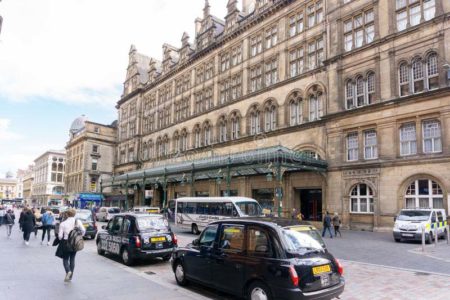
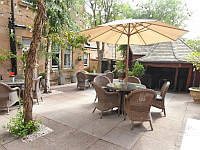
The three of us walked a short distance to Caffe Parma, an Italian restaurant. I have a suspicion Roland might be a regular. (It was packed but we seemed to get a table with no problems). I can’t remember what Sandy or Roland ordered but I had the best seafood mussels (moules) I’d ever eaten. (Of course, they were Scottish.) I could have eaten many more if I had skipped the frites. Roland was gracious to pick up the tab considering he only owed me a beer after losing our bet on the UEFA Men’s Euro 2021 tournament. (I picked Italy to win; Roland unfortunately went with France.)
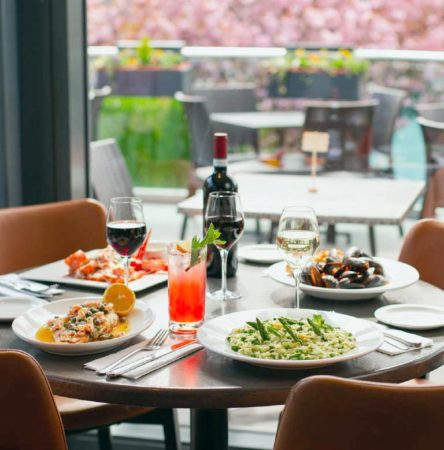
Day Thirteen: A Day in Glasgow with Roland
We spent the day with Roland driving around Glasgow and seeing the sights from the perspective of a native son. A lot of our day was talking (for us, mainly listening) about the history of Glasgow, its architecture, and some of its famous celebrities. The last time I was in Glasgow was the summer of 1973 when a high school friend of mine and I “backpacked” our way across Europe using a Eurail pass. My friend, Harry, had relatives in Glasgow. I don’t remember much from fifty years ago but I’m quite confident the two of us made our way to at least one pub during our short visit back then. I do know that Roland took us to a downtown pub (Stravaigan on Gibson Street) for lunch and the food was very good as was the beer.
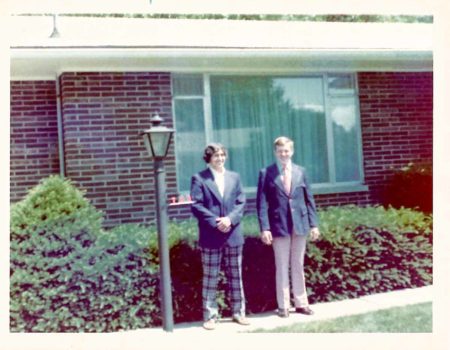
Our first stop was the Kelvingrove Art Gallery and Museum. This is an amazing museum with just about anything for anybody. There are stuffed animals, a World War II Spitfighter aircraft, priceless paintings, heads hanging from the ceiling, collections of odds and ends, and a pipe organ that is played each day. After the museum, we drove around the city passing through and by the university, cathedral, and particularly interesting, the areas down by the river where shipping, ship building, and other activities took place for hundreds of years. Many of these areas have been or in the process of becoming gentrified.
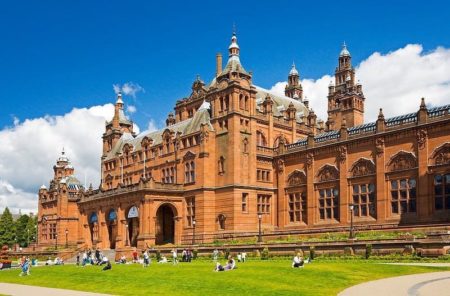
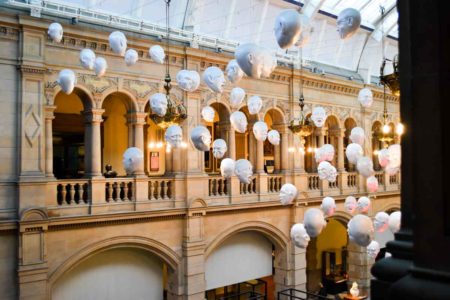
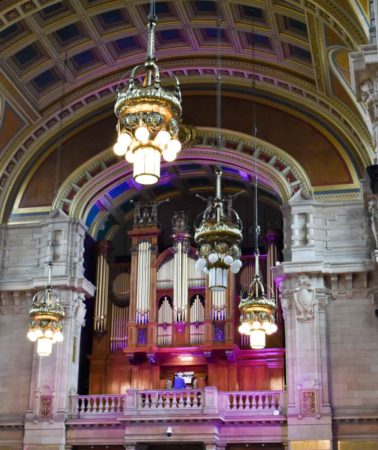
Our last stop was the Glasgow Necropolis, a vast cemetery from the early 19th-century. Roland and I sat down on one of the walls while Sandy wandered off to get her photos.
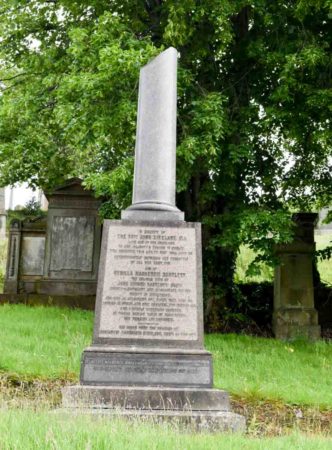
After the cemetery, it was time to say goodbye and Roland dropped us off at the hotel. He had a family get together while we needed to pack for an early morning departure.
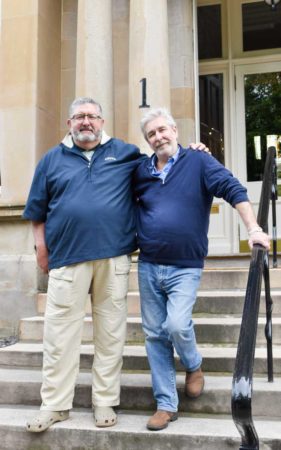
Day Fourteen: Back to Florida
Our day began at 2:00 AM. We flew out of Glasgow to Amsterdam where our flight back to New York originated. Then it was on to Tampa and a short ride home to Punta Gorda. Normally, it only takes us one day to recover but this time, it was a full three days. It was a great trip with a lot of moving pieces. I was surprised everything went off without any problems. We were fortunate to miss the transportation strikes, the oppressive heatwave, and the chaos in the airports. One week later and we would have likely been a pair of miserable travelers.
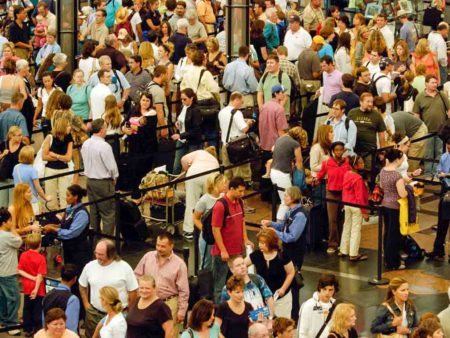
Biggest Disappointment
My biggest disappointment was our trip to Madame Tussauds in London. Sandy’s biggest disappointment was the Paris Sewer Museum (that was a close second for me). London is obscenely expensive (no, I don’t think the exchange rates were the problem).
Best Moments
Certainly, the best moments of our trip were those spent with our friends. We were also pleasantly surprised at how affordable Paris is compared to our prior visits (yes, the exchange rate helped us).
Recommended Places
Here are some of the places where we stayed and places to dine. These are establishments that Sandy and I would not hesitate to again eat at, stay at, or do business with them. Please remember, we do not take any compensation for highlighting or recommending commercial establishments.
Paris
Hotel
Les Deux Girafes
23, passage Beslay
75011 Click here for the web-site.
A four-star hotel that is quite comfortable, within walking distance of two métro stations (lines 3, 5 & 9), and situated in an area of many restaurants. The eleventh is an up-and-coming district. You won’t find many tourists here. Remember to bring your own washcloths.
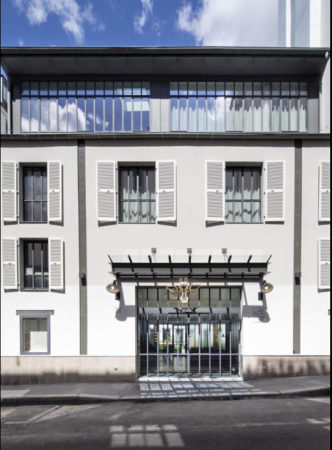
Restaurants
Les Cent Kilos
2, rue de la Folie Méricourt
75011 Click here for the web-site.
A neighborhood French bistro that offers an eclectic menu. Very friendly and accommodating.
Les Rupins
35, bd de Magenta
75010 Click here for the web-site.
Excellent food, very friendly, and centrally located in the tenth district. All their food is homemade. Nice place to unwind after a trying day at the office.
Asian Wok (Thai)
63, rue Oberkampf
75011
A small “mom & pop” place that seems to be quite popular with the folks in the neighborhood. We were lucky to get a table. Excellent food!
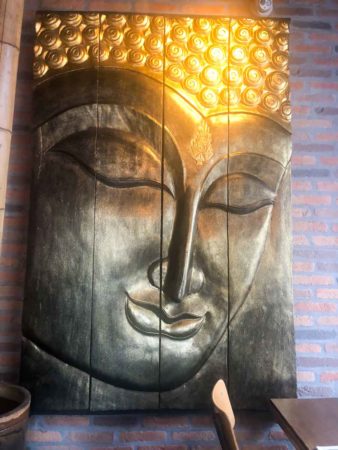
Strasbourg
Hotel
Maison Rouge Strasbourg Hotel & Spa
4, rue des Francs Bourgeois Click here for the web-site.
One of the best hotels we’ve ever stayed in. It is part of Marriott’s Autograph series and located in the pedestrian-only walking zone of the historic district.
Restaurant
La Corde à Linge
2, place Benjamin Zix
Strasbourg
There are plenty of restaurant choices in the historic section of Strasbourg. Raphaëlle picked this one and she did a good job. The menu offers both French and German cuisine (as you can imagine). Eating out on the patio next to the water was fun.
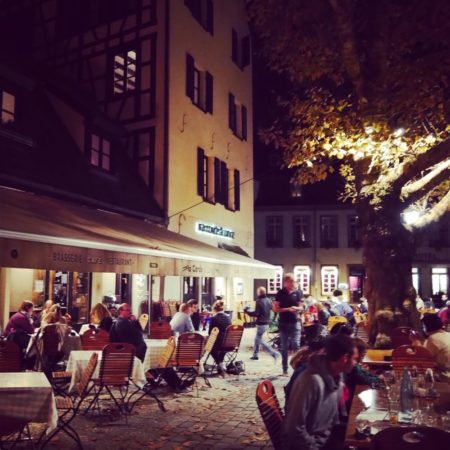
Car Rental
Europcar
Hotel Mercure
15, place de la Gare Click here for the web-site.
No problems whatsoever from time of pickup to drop off. I wouldn’t hesitate to rent from Europcar again.
London
Hotel
Dorset Square Hotel
39-40 Dorset Square Click here for the web-site.
A very quaint hotel situated in one of the best spots of London. Easy walk to the underground (Baker Street), Regent’s Park, a multitude of attractions, and many fine restaurants and pubs. Our room was on the small side with only one window. Next time, I’ll have a better idea of what type of room to reserve.
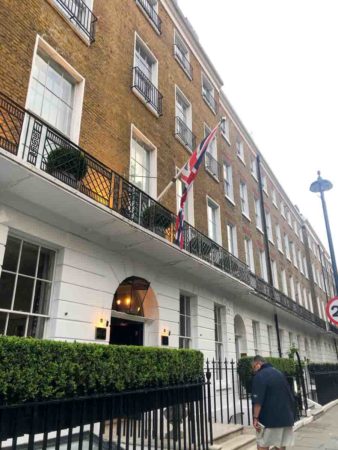
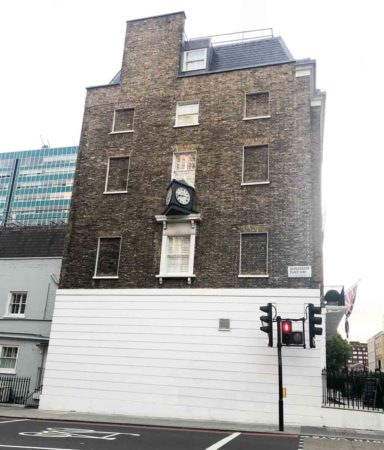
Restaurants
The Rajdoot (Indian)
49 Paddington St. Click here for the web-site.
A small hole-in-the-wall restaurant easily overlooked. However, we voted it one of the best Indian dining experiences we’ve had. Just in case, get a reservation.
Phoenix Palace (Chinese)
5-9 Glentworth Street Click here for the web-site.
This is a very large restaurant and very classic “old-style.” Menu selection is huge and every item we ordered was top-notch. There were clearly many repeat customers. Seems it’s the restaurant where “everyone knows your name.”
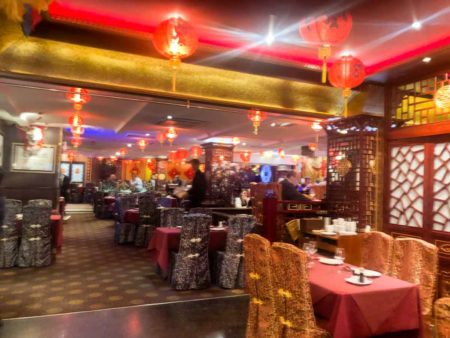
Scott’s (Seafood)
20 Mount Street Click here for the web-site.
Best seafood restaurant by far and very expensive. Reservations are a must. The octopus carpaccio and dover sole are to kill for. This is definitely one of your London “celebrity” restaurants. (We had to beat back the crowds demanding our autographs. Oh wait, that was the red carpet at Madame Tussauds.)
Glasgow
Hotel
Hotel du Vin & Bistro
One Devonshire Gardens Click here for the web-site.
Very unusual and unique layout for a hotel. Comfortable and fun to explore. No air conditioning and the windows only crack open for ventilation. Upscale restaurant with nice bar. Very convenient with Roland guiding us around. Loved the “hobbit” cigar cave in the patio area. Situated in a nice quiet neighborhood and I’m glad I picked this hotel over one located downtown.
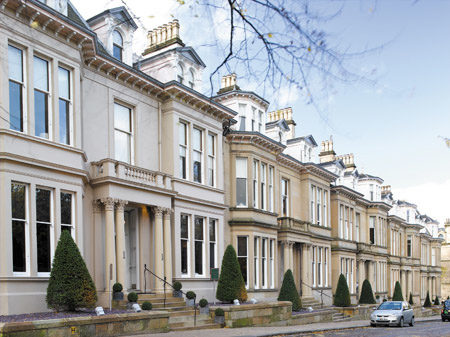
Restaurant
Caffe Parma
30a Hyndland Rd. Click here for the web-site.
Excellent food. Seems reservations are a must unless you are with Roland.
Next Blog: Prince, King and . . . Traitor? – 27 Aug
★ Learn More About Home Slide Shows ★
Hill, Michael. Funny Business: The Legendary Life and Political Satire of Art Buchwald. New York: Random House, 2022.
Hunt, Antonia. Little Resistance: A Teenage English Girl’s Adventures in Occupied France. London: Leo Cooper Secker & Warburg, 1982.
Luard, Tim. Escape from Hong Kong: Admiral Chan Chak’s Christmas Day Dash, 1941. Hong Kong: Hong Kong University Press, 2012.
Soulier, Dominique. The Sussex Plan: Secret War in Occupied France 1943-1945. Paris: Histoire & Collections, 2013.
Williams, Brian (Foreword). Medal of Honor: Portraits of Valor Beyond the Call of Duty. New York: Artisan, 2003.
Disclaimer:
There may be a chance that after we publish this particular blog, the video links associated with the blog are no longer accessible. We have no control over this. Many times, whoever posts the video has done so without the consent of the video’s owner. In some cases, it is likely that the content is deemed unsuitable by YouTube. We apologize if you have tried to access the link and you don’t get the expected results. Same goes for internet links.
What’s New With Sandy and Stew?
As you read this, Sandy and I are likely in Montana visiting with two of our six grandchildren. Each summer, we took our vacations up at Flathead Lake in western Montana. We’d pulled our boat up there from Los Angeles and spend two weeks in a two-story log cabin (150 feet of lake front with a private dock). It’s nice for about four months out of the year⏤kind of like the Upper Peninsula of Michigan.
Thank you to all of you who subscribe to our bi-weekly blogs. It seems there isn’t a day that goes by where we don’t increase our readership. Please let your history buff friends and family members know about our blog site and blogs.
Someone Is Commenting On Our Blogs
I’d like to thank Stephen F. for reaching out to us regarding the blog, Stew and Sandy’s Summer Vacation in Paris (click here to read the blog). Stephen pointed out I had misspelled Vosges. Sandy has corrected that error. Thanks again Stephen for that as well as your nice comments about our blogs.
Derek L. contacted us regarding the blog, SS City of Benares (click here to read the blog). Derek lives in Glasgow and has researched the sinking of the ship. He found a very little-known fact that twenty of the Indian cabin boys and crew also went down with the ship. The oldest wasn’t more than sixteen. We have updated the blog to include that historical fact. Thanks Derek. By the way, do you know anyone who can help me get tickets to next year’s Open?
If there is a topic you’d like to see a blog written about, please don’t hesitate to contact me. I love hearing from you so keep those comments coming.
Share This:
Follow Stew:
Find Stew’s books on Amazon and Apple Books.
Please contact Stew directly for purchase of books, Kindle available on Amazon. Stew.ross@Yooperpublications.com or Contact Stew on the Home Page.
Please note that we do not and will not take compensation from individuals or companies mentioned or promoted in the blogs.
 Walks Through History
Walks Through History
Copyright © 2022 Stew Ross






HI there !
Just read the blog about your trip. Nice, lots of places I know.
First, in case they did not tell you, the name of restaurant “les Rupins” is a slang word for the rich, “les bourgeois”.
Also, you ask about why windows were bricked up at the Dorset ?it has to do with taxes. The more windows you had on a building the more you paid because it suggested that your house was big and therefore had a lot of money. That is why the owners blocked a lot of them. That system also applied to France !
Hi Nicole. Good to hear from you. I did not know about the restaurant’s name being a slang word. I got a chuckle out of your comment. Raphaelle picked the restaurant and I’ll have to mention this to her. As far as the windows, yes I knew about the window tax in England but did not know it was also enforced in France. Good to know! Talk soon. STEW